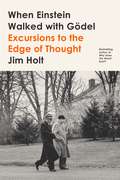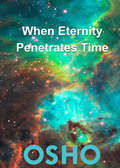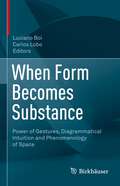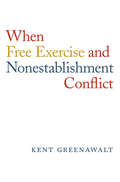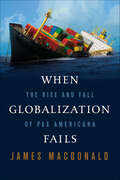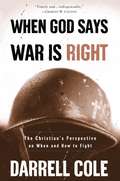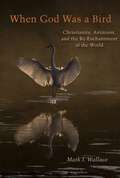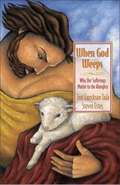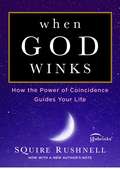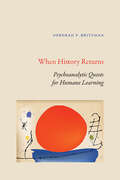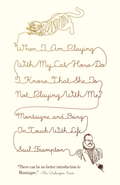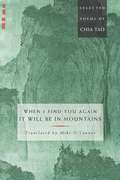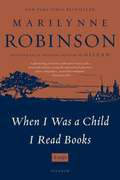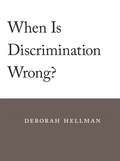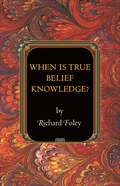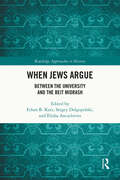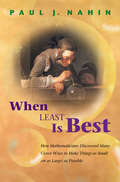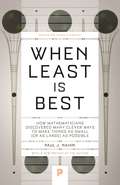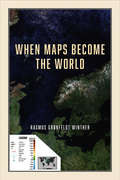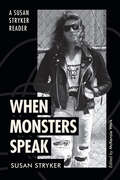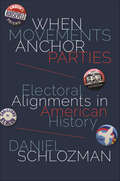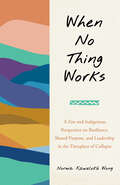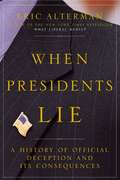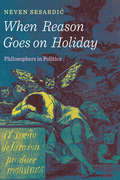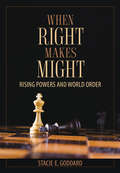- Table View
- List View
When Einstein Walked with Gödel: Excursions to the Edge of Thought
by Jim HoltFrom Jim Holt, the New York Times bestselling author of Why Does the World Exist?, comes an entertaining and accessible guide to the most profound scientific and mathematical ideas of recent centuries in When Einstein Walked with Gödel: Excursions to the Edge of Thought.Does time exist? What is infinity? Why do mirrors reverse left and right but not up and down? In this scintillating collection, Holt explores the human mind, the cosmos, and the thinkers who’ve tried to encompass the latter with the former. With his trademark clarity and humor, Holt probes the mysteries of quantum mechanics, the quest for the foundations of mathematics, and the nature of logic and truth. Along the way, he offers intimate biographical sketches of celebrated and neglected thinkers, from the physicist Emmy Noether to the computing pioneer Alan Turing and the discoverer of fractals, Benoit Mandelbrot. Holt offers a painless and playful introduction to many of our most beautiful but least understood ideas, from Einsteinian relativity to string theory, and also invites us to consider why the greatest logician of the twentieth century believed the U.S. Constitution contained a terrible contradiction—and whether the universe truly has a future.
When Eternity Penetrates Time
by Osho Osho International FoundationTime is that in which we live -- it is horizontal. It is from A to B to C to D; it is in a line. Eternity is vertical. It is not from A to B and from B to C. It is from A to more A to still more A. It goes on upwards. The moment is rare because it happens only when meditation has reached ripening, maturity, when you have touched your innermost core. The vertical line opens a door to eternity. Taken from a series: Hari Om Tat Sat, by Osho
When Form Becomes Substance: Power of Gestures, Diagrammatical Intuition and Phenomenology of Space
by Carlos Lobo Luciano BoiThis interdisciplinary volume collects contributions from experts in their respective fields with as common theme diagrams.Diagrams play a fundamental role in the mathematical visualization and philosophical analysis of forms in space. Some of the most interesting and profound recent developments in contemporary sciences, whether in topology, geometry, dynamic systems theory, quantum field theory or string theory, have been made possible by the introduction of new types of diagrams, which, in addition to their essential role in the discovery of new classes of spaces and phenomena, have contributed to enriching and clarifying the meaning of the operations, structures and properties that are at the heart of these spaces and phenomena.The volume gives a closer look at the scope and the nature of diagrams as constituents of mathematical and physical thought, their function in contemporary artistic work, and appraise, in particular, the actual importance of the diagrams of knots, of braids, of fields, of interaction, of strings in topology and geometry, in quantum physics and in cosmology, but also in theory of perception, in plastic arts and in philosophy. The editors carefully curated this volume to be an inspiration to students and researchers in philosophy, phenomenology, mathematics and the sciences, as well as artists, musicians and the general interested audience.
When Free Exercise and Nonestablishment Conflict
by Kent Greenawalt“Congress shall make no law reflecting an establishment of religion or prohibiting the free exercise thereof.” The First Amendment aims to separate church and state, but Kent Greenawalt examines many situations in which its two clauses—the Nonestablishment Clause and the Free Exercise Clause—point in opposite directions. How should courts decide?
When Globalization Fails: The Rise and Fall of Pax Americana
by James MacDonaldThis sweeping history examines two centuries of global trade and warfare, shedding new light on the relationship between economics and conflict.In the nineteenth century, liberals exulted that the spread of commerce would usher in global prosperity and peace, but these dreams were dashed by imperial squabbles, the carnage of 1914–18, and the protectionism, depression, and conflict that followed. In the wake of World War II, the globalists tried again. With the Communist bloc disconnected from the global economy, a new international order was created, buttressing free trade with the informal supremacy of the United States. But this benign period is coming to an end.Expertly combining political, economic, and military history, James Macdonald argues that if industrial nations are more prosperous, they are also more vulnerable. While a dependence on trade may push toward cooperation, the attendant insecurity pulls in the opposite direction, leading to conflict.In Macdonald’s telling, World War I’s naval blockades were as important as its trenches, and World War II was a struggle for raw materials in a world that had rejected free trade. Today, the Pax Americana that kept insecurities at bay is being undermined by China’s rise, with potentially dangerous consequences. Rich in original historical analysis and enlivened by vivid quotation, When Globalization Fails recasts what we know about war, peace, and trade, and raises vital questions about the future.
When God Says War Is Right: The Christian's Perspective on When and How to Fight
by Darrell ColeAcross the centuries, how have Christians who follow the Prince of Peace responded to the recurring reality of war? And what guidance do they offer for believers todayuin the midst of global conflict? In When God Says War Is Right, Dr. Darrell Cole offers thorough and highly readable answers. His expert examination focuses on these topics: Relating the character of God with the use of force Determining when and how Christians ought to fight Understanding why Christian virtues are vital when using force Using nuclear weapons for deterrence Learning lessons from World War II, Vietnam, and the 1991 Gulf War Responding to today's war against terrorism Dr. Cole focuses on Romans 13, where Paul commands us to do what is righto (or goodo or nobleo) in regard to our governing authorities, who have legitimate war-making authority. In the case of war, what is righto for the Christian? This book answers that essential question. In today's war-stricken world, Dr. Cole provides timely, trustworthy, and vitally needed guidance for Christians.
When God Was a Bird: Christianity, Animism, and the Re-Enchantment of the World (Groundworks: Ecological Issues in Philosophy and Theology)
by Mark I. Wallace2019 NAUTILUS GOLD WINNERIn a time of rapid climate change and species extinction, what role have the world’s religions played in ameliorating—or causing—the crisis we now face? Religion in general, and Christianity in particular, appears to bear a disproportionate burden for creating humankind’s exploitative attitudes toward nature through unearthly theologies that divorce human beings and their spiritual yearnings from their natural origins. In this regard, Christianity has become an otherworldly religion that views the natural world as “fallen,” as empty of signs of God’s presence.And yet, buried deep within the Christian tradition are startling portrayals of God as the beaked and feathered Holy Spirit – the “animal God,” as it were, of historic Christian witness. Through biblical readings, historical theology, continental philosophy, and personal stories of sacred nature, this book recovers the model of God in Christianity as a creaturely, avian being who signals the presence of spirit in everything, human and more-than-human alike. Mark Wallace’s recovery of the bird-God of the Bible signals a deep grounding of faith in the natural world. The moral implications of nature-based Christianity are profound. All life is deserving of humans’ care and protection insofar as the world is envisioned as alive with sacred animals, plants, and landscapes. From the perspective of Christian animism, the Earth is the holy place that God made and that humankind is enjoined to watch over and cherish in like manner. Saving the environment, then, is not a political issue on the left or the right of the ideological spectrum, but, rather, an innermost passion shared by all people of faith and good will in a world damaged by anthropogenic warming, massive species extinction, and the loss of arable land, potable water, and breathable air. To Wallace, this passion is inviolable and flows directly from the heart of Christian teaching that God is a carnal, fleshy reality who is promiscuously incarnated within all things, making the whole world a sacred embodiment of God’s presence, and worthy of our affectionate concern. This beautifully and accessibly written book shows that “Christian animism” is not a strange oxymoron, but Christianity’s natural habitat. Challenging traditional Christianity’s self-definition as an other-worldly religion, Wallace paves the way for a new Earth-loving spirituality grounded in the ancient image of an animal God.
When God Weeps: Why Our Sufferings Matter to the Almighty
by Joni Eareckson Tada Steve EstesThis book is about God weeping over human heartache, his entering our anguish himself, and the love that drives him to let us suffer. It's about experiencing the friendship of God along difficult paths we didn't even know he walked. Much of it is written from Joni's perspective because her life is a remarkable laboratory that proves God knows what he's talking about. But your life is the important laboratory to put God's Word to the test as you read.
When God Winks: How the Power of Coincidence Guides Your Life (The Godwink Series #1)
by Squire RushnellIt is not by accident that you just picked up When God Winks.Whether you call it synchronicity or coincidence, what brought you to this book today is worth remembering. In fact, you may have suspected all along that there is more to coincidence than meets the eye. These seemingly random events are actually signposts that can help you successfully navigate your career, relationships, and interests. Squire Rushnell shows us that by recognizing our "God Winks," we can use the untapped power of coincidence to vastly improve our lives. The author applies his compelling theory as to why coincidences exist to fascinating stories in history, sports, medicine, and relationships involving both everyday and famous people including Barbra Streisand, Charles Schulz, Oprah Winfrey, Kevin Costner, Mark Twain, and Presidents John Adams and Thomas Jefferson.
When History Returns: Psychoanalytic Quests for Humane Learning (SUNY series, Transforming Subjects: Psychoanalysis, Culture, and Studies in Education)
by Deborah P. BritzmanWhen History Returns brings together psychoanalytic theories of learning with the antinomies of social strife. From a psychoanalytic perspective, history returns through transitional scenes of inheriting a past one could not make, experiencing a present affected by what came before, and facing a future one can neither know nor predict. Taking such scenes as the subject of education, Deborah P. Britzman provides new approaches and vocabulary for conceptualizing experience and understanding, as expressed in psychoanalysis, literature, film, clinical case studies, and warm pedagogy. Britzman argues that novel quests for humane responsibility take hold in the fallout of understanding, in the feel of history, in imaginative dialogues and missed encounters, and in searches for friendship, belonging, and affiliation. Each chapter charts these quests in contemporary education, carrying readers into the heart of learning and the emotional situations that urge the transitions of difficult knowledge into care for thinking and the questions that follow.
When I Am Playing with My Cat, How Do I Know That She Is Not Playing with Me?
by Saul Frampton"When I dance, I dance; when I sleep, I sleep. And when Iam walking alone in a beautiful orchard, if my thoughtsare sometimes preoccupied elsewhere, the rest of the time Ibring them back to the walk, to the orchard, to the sweetnessof this solitude, and to me."--Montaigne In the year 1570, at the age of thirty-seven, Michel de Montaigne gave up his job as a magistrate and retired to his château to brood on his own private grief--the deaths of his best friend, his father, his brother, and his firstborn child. On the ceiling of his library he inscribed a phrase from the Roman poet and philosopher Lucretius: "There is no new pleasure to be gained by living longer." But finding his mind agitated rather than settled by this idleness, Montaigne began to write, giving birth to the Essays--short prose explorations of an amazingly wide range of subjects. And gradually, over the course of his writing, Montaigne rejected his stoical pessimism and turned from a philosophy of death to a philosophy of life. He erased Lucretius's melancholy fatalism and began to embrace the exuberant vitality of living, finding an antidote to death in the most unlikely places--the touch of a hand, the smell of his doublet, the playfulness of his cat, and the flavor of his wine. Saul Frampton offers a celebration of perhaps the most enjoyable and yet profound of all Renaissance writers, whose essays went on to have a huge impact on figures as diverse as Shakespeare, Emerson, and Orson Welles, and whose thoughts, even today, offer a guide and unprecedented insight into the simple matter of being alive.From the Hardcover edition.
When I Find You Again, It Will Be in Mountains: The Selected Poems of Chia Tao
by Mike O'ConnorChia Tao (779-843), an erstwhile Zen monk who became a poet during China's Tang dynasty, recorded the lives of the sages, masters, immortals, and hermits who helped establish the great spiritual tradition of Zen Buddhism in China. Presented in both the original Chinese and Mike O'Connor's beautifully crafted English translation, When I Find You Again, It Will Be in Mountains brings to life this preeminent poet and his glorious religious tradition, offering the fullest translation of Chia Tao's poems to date.
When I Was a Child I Read Books
by Marilynne RobinsonWhen I Was a Child I Read Books' tackles the charged political and social climate in this country, the deeply embedded role of generosity in Christian faith, and the nature of individualism and the myth of the American West.
When Is Discrimination Wrong?
by Deborah HellmanA law requires black bus passengers to sit in the back of the bus. The U.S. Food and Drug Administration approves a drug for use by black heart failure patients. A state refuses to license drivers under age 16. A company avoids hiring women between the ages of 20 and 40. We routinely draw distinctions among people on the basis of characteristics that they possess or lack. While some distinctions are benign, many are morally troubling.In this boldly conceived book, Deborah Hellman develops a much-needed general theory of discrimination. She demonstrates that many familiar ideas about when discrimination is wrong—when it is motivated by prejudice, grounded in stereotypes, or simply departs from merit-based decision-making—won’t adequately explain our widely shared intuitions.Hellman argues that, in the end, distinguishing among people on the basis of traits is wrong when it demeans any of the people affected. She deftly explores the question of how we determine what is in fact demeaning.Claims of wrongful discrimination are among the most common moral claims asserted in public and private life. Yet the roots of these claims are often left unanalyzed. When Is Discrimination Wrong? explores what it means to treat people as equals and thus takes up a central problem of democracy.
When Is True Belief Knowledge? (Princeton Monographs in Philosophy #38)
by Richard FoleyA woman glances at a broken clock and comes to believe it is a quarter past seven. Yet, despite the broken clock, it really does happen to be a quarter past seven. Her belief is true, but it isn't knowledge. This is a classic illustration of a central problem in epistemology: determining what knowledge requires in addition to true belief. In this provocative book, Richard Foley finds a new solution to the problem in the observation that whenever someone has a true belief but not knowledge, there is some significant aspect of the situation about which she lacks true beliefs--something important that she doesn't quite "get." This may seem a modest point but, as Foley shows, it has the potential to reorient the theory of knowledge. Whether a true belief counts as knowledge depends on the importance of the information one does or doesn't have. This means that questions of knowledge cannot be separated from questions about human concerns and values. It also means that, contrary to what is often thought, there is no privileged way of coming to know. Knowledge is a mutt. Proper pedigree is not required. What matters is that one doesn't lack important nearby information. Challenging some of the central assumptions of contemporary epistemology, this is an original and important account of knowledge.
When Jews Argue: Between the University and the Beit Midrash (Routledge Approaches to History)
by Ethan B. Katz Sergey Dolgopolski Elisha AncselovitsThis book re-thinks the relationship between the world of the traditional Jewish study hall (the Beit Midrash) and the academy: Can these two institutions overcome their vast differences? Should they attempt to do so? If not, what could two methods of study seen as diametrically opposed possibly learn from one another? How might they help each other reconceive their interrelationship, themselves, and the broader study of Jews and Judaism? This book begins with three distinct approaches to these challenges. The chapters then follow the approaches through an interdisciplinary series of pioneering case studies that reassess a range of topics including religion and pluralism in Jewish education; pain, sexual consent, and ethics in the Talmud; the place of reason and devotion among Jewish thinkers as diverse as Moses Mendelssohn, Jacob Taubes, Sarah Schenirer, Ibn Chiquitilla, Yair Ḥayim Bacharach, and the Rav Shagar; and Jewish law as a response to the post-Holocaust landscape. The authors are scholars of rabbinics, history, linguistics, philosophy, law, and education, many of whom also have traditional religious training or ordination. The result is a book designed for learned scholars, non-specialists, and students of varying backgrounds, and one that is sure to spark debate in the university, the Beit Midrash, and far beyond.
When Least Is Best
by Paul J. NahinWhat is the best way to photograph a speeding bullet? Why does light move through glass in the least amount of time possible? How can lost hikers find their way out of a forest? What will rainbows look like in the future? Why do soap bubbles have a shape that gives them the least area? By combining the mathematical history of extrema with contemporary examples, Paul J. Nahin answers these intriguing questions and more in this engaging and witty volume. He shows how life often works at the extremes--with values becoming as small (or as large) as possible--and how mathematicians over the centuries have struggled to calculate these problems of minima and maxima. From medieval writings to the development of modern calculus to the current field of optimization, Nahin tells the story of Dido's problem, Fermat and Descartes, Torricelli, Bishop Berkeley, Goldschmidt, and more. Along the way, he explores how to build the shortest bridge possible between two towns, how to shop for garbage bags, how to vary speed during a race, and how to make the perfect basketball shot. Written in a conversational tone and requiring only an early undergraduate level of mathematical knowledge, When Least Is Best is full of fascinating examples and ready-to-try-at-home experiments. This is the first book on optimization written for a wide audience, and math enthusiasts of all backgrounds will delight in its lively topics.
When Least Is Best: How Mathematicians Discovered Many Clever Ways to Make Things as Small (or as Large) as Possible (Princeton Science Library #118)
by Paul J. NahinA mathematical journey through the most fascinating problems of extremes and how to solve themWhat is the best way to photograph a speeding bullet? How can lost hikers find their way out of a forest? Why does light move through glass in the least amount of time possible? When Least Is Best combines the mathematical history of extrema with contemporary examples to answer these intriguing questions and more. Paul Nahin shows how life often works at the extremes—with values becoming as small (or as large) as possible—and he considers how mathematicians over the centuries, including Descartes, Fermat, and Kepler, have grappled with these problems of minima and maxima. Throughout, Nahin examines entertaining conundrums, such as how to build the shortest bridge possible between two towns, how to vary speed during a race, and how to make the perfect basketball shot. Moving from medieval writings and modern calculus to the field of optimization, the engaging and witty explorations of When Least Is Best will delight math enthusiasts everywhere.
When Maps Become the World
by Rasmus Grønfeldt WintherMap making and, ultimately, map thinking is ubiquitous across literature, cosmology, mathematics, psychology, and genetics. We partition, summarize, organize, and clarify our world via spatialized representations. Our maps and, more generally, our representations seduce and persuade; they build and destroy. They are the ultimate record of empires and of our evolving comprehension of our world. This book is about the promises and perils of map thinking. Maps are purpose-driven abstractions, discarding detail to highlight only particular features of a territory. By preserving certain features at the expense of others, they can be used to reinforce a privileged position.When Maps Become the World shows us how the scientific theories, models, and concepts we use to intervene in the world function as maps, and explores the consequences of this, both good and bad. We increasingly understand the world around us in terms of models, to the extent that we often take the models for reality. Winther explains how in time, our historical representations in science, in cartography, and in our stories about ourselves replace individual memories and become dominant social narratives—they become reality, and they can remake the world.
When Monsters Speak: A Susan Stryker Reader (ASTERISK)
by Susan StrykerSusan Stryker is a foundational figure in trans studies. When Monsters Speak showcases the development of Stryker’s writing from the 1990s to the present. It combines canonical pieces, such as “My Words to Victor Frankenstein,” with her hard to find earlier work published in zines and newsletters. Brought together, they ground Stryker’s thought in 1990s San Francisco and its innovative queer, trans, and S/M cultures. The volume includes an introduction by editor McKenzie Wark, who highlights Stryker’s connections to developments in queer theory, media studies, and autotheory while foregrounding Stryker’s innovative writing style and scholarly methods. When Monsters Speak is an authoritative and essential collection by one of the most important and influential intellectuals of our time.
When Movements Anchor Parties: Electoral Alignments in American History (Princeton Studies in American Politics: Historical, International, and Comparative Perspectives)
by Daniel SchlozmanThroughout American history, some social movements, such as organized labor and the Christian Right, have forged influential alliances with political parties, while others, such as the antiwar movement, have not. When Movements Anchor Parties provides a bold new interpretation of American electoral history by examining five prominent movements and their relationships with political parties.Taking readers from the Civil War to today, Daniel Schlozman shows how two powerful alliances—those of organized labor and Democrats in the New Deal, and the Christian Right and Republicans since the 1970s—have defined the basic priorities of parties and shaped the available alternatives in national politics. He traces how they diverged sharply from three other major social movements that failed to establish a place inside political parties—the abolitionists following the Civil War, the Populists in the 1890s, and the antiwar movement in the 1960s and 1970s. Moving beyond a view of political parties simply as collections of groups vying for preeminence, Schlozman explores how would-be influencers gain influence—or do not. He reveals how movements join with parties only when the alliance is beneficial to parties, and how alliance exacts a high price from movements. Their sweeping visions give way to compromise and partial victories. Yet as Schlozman demonstrates, it is well worth paying the price as movements reorient parties' priorities.Timely and compelling, When Movements Anchor Parties demonstrates how alliances have transformed American political parties.
When No Thing Works: A Zen and Indigenous Perspective on Resilience, Shared Purpose, and Leadership in the Timeplace of Collapse
by Norma WongSpiritual and community lessons for embracing collective care, co-creating sustainable worlds, and responsibly meeting uncertain futures—a Zen and Indigenous take on building better, more balanced ways of being For readers of Hospicing Modernity, When Things Fall Apart, and Zen and the Art of Saving the PlanetTalking story, weaving poetry, and offering wisdom at the intersections of strategy, politics, and spiritual activism, When No Thing Works is a visionary guide to co-creating new worlds from one in crisis. It asks into the ways we can live well and maintain our wholeness in an era of collective acceleration: the swiftly moving current, fed and shaped by human actions, that sweeps us toward ever uncertain futures. Grounded in Zen Buddhism, interconnection, and decades of community activism, When No Thing Works explores questions like:As we stand at a threshold of collective change, what leaps must we make?How can we push through discord and polarization and meet these critical changepoints collectively?What practices, strategies, and spiritualities can align to vision a sustainable future for our communities and descendents?How can we step out of urgency to tend to our crises with wisdom, intention, and care? With wise and witty prose that wanders and turns, guides and reveals, Zen master and Indigenous Hawaiian leader Rōshi Norma Wong&’s meditation holds our collective moment with gravity and tender care. She asks us to not only imagine but to live into a story beyond crisis and collapse—one that expands to meet our dreams of what (we hope) comes next, while facing with clarity and grace our here and now in the world we share today.
When Presidents Lie
by Eric AltermanLying has become pervasive in American life-but what happens when the falsehoods are perpetrated by the Oval Office? As the lies told by our government become more and more intricate, they begin to weave a tapestry of deception that creates problems far larger than those lied about in the first place. Eric Alterman's When Presidents Lieis a compelling historical examination of four specific post-World War II presidential lies whose consequences were greater than could ever have been predicted. FDR told the American people that peace was secure in Europe, setting the stage for McCarthyism and the cold war. John F. Kennedy's unyielding stance during the Cuban missile crisis masked his secret deal with the Soviet Union. Misrepresented aggression at the Gulf of Tonkin by the North Vietnamese gave LBJ the power to start a war. Finally, Ronald Reagan's Central American wars ended in the ignominy of the Iran-contra scandal. In light of George W. Bush's war in Iraq, which Alterman examines in the book's conclusion, When Presidents Lieis a warning-one more relevant today than ever before-that the only way to prevent these lies is America's collective demand for truth.
When Reason Goes on Holiday: Philosophers in Politics
by Neven SesardicPhilosophers usually emphasize the importance of logic, clarity and reason. Therefore when they address political issues they will usually inject a dose of rationality in these discussions, right?Wrong. This book gives a lot of examples showing the unexpected level of political irrationality among leading contemporary philosophers. The body of the book presents a detailed analysis of extreme leftist views of a number of famous philosophers and their occasional descent into apology for-and occasionally even active participation in-totalitarian politics. Most of these episodes are either virtually unknown (even inside the philosophical community) or have received very little attention.The author tries to explain how it was possible that so many luminaries of twentieth-century philosophy, who invoked reason and exhibited rigor and careful thinking in their professional work, succumbed to irrationality and ended up supporting some of the most murderous political regimes and ideologies. The huge leftist bias in contemporary philosophy and its persistence over the years is certainly a factor but it is far from being the whole story.Interestingly, the indisputably high intelligence of these philosophers did not actually protect them from descending into political insanity. It is argued that, on the contrary, both their brilliance and the high esteem they enjoyed in the profession only made them more self-confident and less cautious, thereby eventually making them blind to their betrayal of reason and the monstrosity of the causes they defended.
When Right Makes Might: Rising Powers and World Order (Cornell Studies in Security Affairs)
by Stacie E. GoddardWhy do great powers accommodate the rise of some challengers but contain and confront others, even at the risk of war? When Right Makes Might proposes that the ways in which a rising power legitimizes its expansionist aims significantly shapes great power responses. Stacie E. Goddard theorizes that when faced with a new challenger, great powers will attempt to divine the challenger’s intentions: does it pose a revolutionary threat to the system or can it be incorporated into the existing international order? Goddard departs from conventional theories of international relations by arguing that great powers come to understand a contender’s intentions not only through objective capabilities or costly signals but by observing how a rising power justifies its behavior to its audience. To understand the dynamics of rising powers, then, we must take seriously the role of legitimacy in international relations.A rising power’s ability to expand depends as much on its claims to right as it does on its growing might. As a result, When Right Makes Might poses significant questions for academics and policymakers alike. Underpinning her argument on the oft-ignored significance of public self-presentation, Goddard suggests that academics (and others) should recognize talk’s critical role in the formation of grand strategy. Unlike rationalist and realist theories that suggest rhetoric is mere window-dressing for power, When Right Makes Might argues that rhetoric fundamentally shapes the contours of grand strategy. Legitimacy is not marginal to international relations; it is essential to the practice of power politics, and rhetoric is central to that practice.
